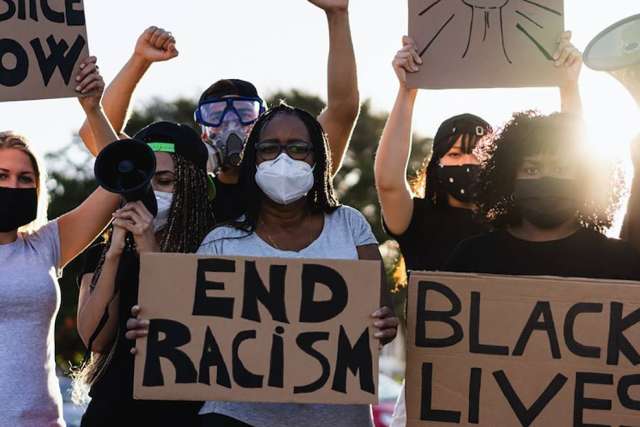Rallies, marches and peaceful protests are a constitutionally protected way to make your voice heard and this year, in particular, people are speaking out in large groups. Still, as the pandemic continues, those exercising their right to peaceful assembly should take extra precautions.
Though no public gathering is completely safe, doctors and public health professionals recognize that people may feel compelled to demonstrate, and observing some additional safety steps may reduce the risk of illness or injury.
Masks, sanitizer, physical distancing
Face masks remain a must, says Russell G. Buhr, MD, PhD, assistant clinical professor at the David Geffen School of Medicine at UCLA and a pulmonary and critical care physician. Keep hand sanitizer handy and use it regularly. Maintain as much physical distance from fellow protesters as circumstances allow. “We know a good proportion of people infected with COVID-19 don’t have symptoms, so using extra caution is critical for protecting yourself and others,” he says.
And if you’re not feeling well, sit it out. “Staying home when you’re sick is important for your health and that of other demonstrators,” says Dr. Buhr.
The Los Angeles County Department of Public Health also suggests avoiding areas where crowds may become congested and refraining from sharing food or drinks with others.
Chemical irritants
There are also safety concerns when it comes to the use of chemical irritants such as pepper spray or tear gas during protests.
Dr. Buhr recommends wearing long sleeves, long pants and sturdy shoes to protect the body as much as possible. Also, opt for glasses instead of contact lenses – they’re easier to wash free of chemicals.
“Eye protection is particularly important for riot-control agents like tear gas or pepper spray and rubber bullets or bean-bag rounds,” he says.
If you are exposed to chemical irritants while wearing contact lenses, “get the contacts out as soon as possible,” Dr. Buhr says. “Bringing some baby shampoo or diluted dish soap and using that with water to wash these agents from the eyes will work better than milk or plain water alone.”
Consider bringing ear plugs, which can be helpful if flash-bang grenades are deployed. However, leave headphones and music at home — you want to stay alert to your surroundings. Trampling can be a danger should violence break out, Dr. Buhr says.
“Maintaining awareness of ways out of a situation as it starts to escalate is critically important,” he says. “If things are escalating beyond your comfort level, walk briskly but try not to run to get out of harm’s way.”
Be sure to keep track of any people with you, particularly those who are more vulnerable, including children, seniors and people with disabilities.
Emergency information
Keep emergency contact information on your person. Include whom to call, any major medical concerns, allergies to medicines and any medications you take, Dr. Buhr says. Some people write these details on their skin in permanent marker so they can’t become separated from them. But jotting them on a piece of paper and tucking it inside a sealed plastic bag to prevent damage if it gets wet should suffice.
“This is extremely helpful to medical staff if you’re brought in injured or ill,” Dr. Buhr says.
Dr. Buhr also suggests carrying a ready supply of medication you might need, such as asthma inhalers or EpiPens.
And finally, don’t forget to inform your emergency contact of your medical details and the approximate location of the protest you plan to join.




